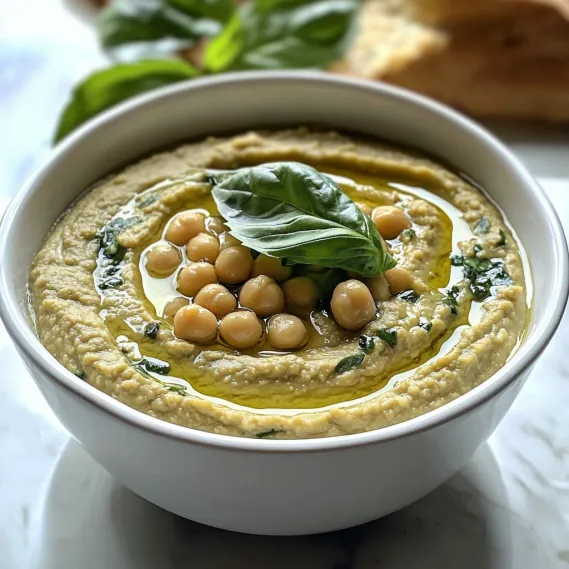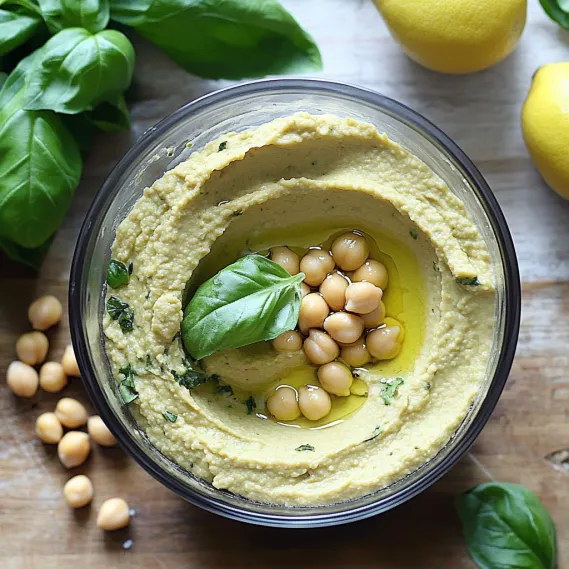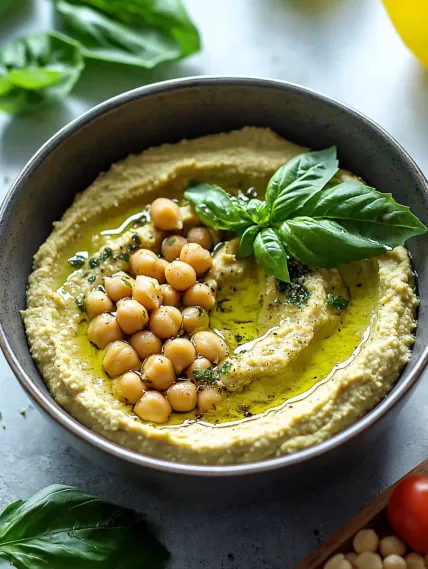 Pin
Pin
This lemon basil hummus transforms ordinary chickpeas into a vibrant, aromatic dip that balances earthy, citrusy, and herbaceous notes perfectly. The fresh basil adds a stunning green hue and unexpected flavor twist to traditional hummus.
I first made this hummus for a summer garden party, and it disappeared faster than any other dish on the table. Now I keep a batch in my refrigerator almost weekly as a healthy snack option that never feels like a compromise.
Ingredients
- Chickpeas: Form the protein rich base and create that classic hummus texture
- Fresh basil leaves: Provide vibrant color and distinct aromatic notes
- Tahini: Adds creaminess and authentic Mediterranean flavor
- Olive oil: Creates silky smoothness and enhances mouthfeel
- Lemon juice: Brightens the entire dish with necessary acidity
- Garlic cloves: Intensify depth of flavor; choose fresh over pre-minced
- Salt: Balances and enhances all other flavors
- Water: Adjusts consistency to your preference
How To Make Lemon Basil Hummus
- Prepare the chickpeas:
- Thoroughly rinse canned chickpeas under cool water until no more foam appears. This removes excess starch and sodium, resulting in cleaner flavor. Allow to drain completely in a colander for about 2 minutes.
- Layer ingredients strategically:
- Add ingredients to your blender or food processor in the proper order: chickpeas and wet ingredients at the bottom near the blade, with delicate basil leaves at the top. This ensures even processing without overwhelming the motor.
- Begin careful blending:
- Start with short pulses rather than continuous blending. This allows the heavier ingredients to break down before incorporating the basil. After initial chopping, drizzle water slowly through the lid opening while machine runs.
- Adjust consistency:
- Continue blending for 2 to 3 minutes until completely smooth. Stop occasionally to scrape down sides with a rubber spatula. The finished texture should be thick but spreadable, similar to soft cream cheese.
- Present thoughtfully:
- Transfer to a shallow serving bowl and create a slight well in the center with the back of a spoon. Drizzle with additional olive oil and garnish with whole basil leaves and a light sprinkle of paprika for visual appeal.

The tahini is truly my secret weapon in this recipe. I splurge on high quality versions made from hulled sesame seeds that have been slowly stone ground. The difference in flavor is remarkable, adding a nutty complexity that elevates the entire dish beyond ordinary hummus.
Make Ahead Options
This hummus actually improves with time as flavors meld together. Make it up to three days before serving and store in an airtight container in the refrigerator. The bright green color will naturally darken slightly, but the flavor remains exceptional. To refresh before serving, stir in a teaspoon of fresh lemon juice and drizzle with additional olive oil.
Creative Serving Ideas
Move beyond the expected pita triangles and try serving this vibrant hummus as part of a composed dish. Spread a thick layer on a plate and top with roasted vegetables, toasted pine nuts, and a sprinkle of za'atar seasoning. Alternatively, use as a nutrient dense spread in wraps or as a replacement for mayonnaise in sandwiches. For a stunning party presentation, fill small endive leaves with hummus for elegant, edible scoops.

Troubleshooting Texture
If your hummus seems too thick, add additional water one tablespoon at a time until desired consistency is reached. Conversely, if it seems too thin, add more chickpeas. For ultra smooth restaurant quality hummus, consider removing the thin skins from chickpeas before blending. While time consuming, this extra step creates incomparably silky results. Another professional technique involves adding 1/4 teaspoon of baking soda to the chickpeas and letting them simmer for 20 minutes before draining and proceeding with the recipe.
Recipe FAQs
- → Can I use dried chickpeas instead of canned?
Yes, dried chickpeas can be used. Soak them overnight, then cook until tender before proceeding with the recipe. Ensure they are soft for a smooth consistency.
- → What can I substitute for tahini?
Sunflower seed butter, almond butter, or peanut butter can be used as substitutes for tahini. While the flavor will differ slightly, these alternatives work well.
- → How long does the hummus stay fresh?
Stored in an airtight container in the refrigerator, this hummus will stay fresh for up to 4-5 days. Stir before serving if separation occurs.
- → Can I make this without a blender?
While a blender or food processor yields the smoothest consistency, you can mash the ingredients by hand or use a potato masher for a chunkier texture.
- → What can I serve with lemon basil hummus?
This hummus pairs great with fresh vegetables, pita bread, crackers, or even as a spread on sandwiches, wraps, or bagels.
- → Can I freeze this hummus?
Yes, you can freeze hummus in an airtight container for up to 3 months. Thaw in the refrigerator and stir well before serving.
